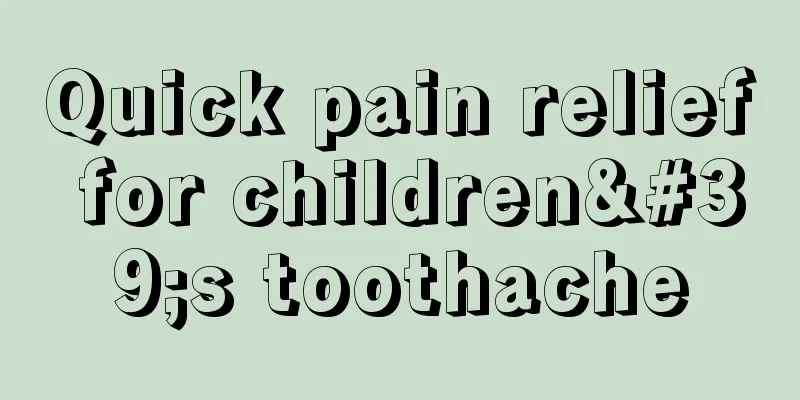What should I do if my child has a muscle strain?

|
Many children do not exercise regularly, and they always suffer from muscle strain when they exercise occasionally, especially when climbing stairs or jumping. Generally speaking, muscle strain will cause soreness and pain. The symptoms of muscle strain will be more severe on the second day, and sometimes even affect walking. So what should we do when children suffer a muscle strain? There is no fixed pattern to muscle strain, and it is difficult to find a universal method to prevent and treat it. Muscle strain is related to many factors, such as genetic factors, because the ratio of fast and slow muscle fibers in muscles is related to genetics. Warming up thoroughly before strenuous exercise is a very effective way to prevent muscle strain. Additionally, fatigue is a potential risk for muscle strain. There are many ways to deal with muscle strain. An effective method is: put a towel on the strained muscle, put ice cubes in a plastic bag and place it on the towel for cold compress for half an hour until the pain in the injured area is relieved. This can be repeated several times a day; wrap an elastic bandage around the injured area, raise the leg, and minimize the swelling caused by bleeding after the injury. Bandage should be done within 30 minutes and can be repeated several times. Try to reduce the burden on the affected limb and keep the affected part quiet. You can take a hot bath or apply hot compress to the affected part two days after the injury. After the bath, apply some blood-activating and swelling-reducing ointment such as Health.Bone Vitality. Do not do running and jumping exercises within one week after injury. After a week, do gentle stretching exercises when there is no pain. After 2 to 3 weeks, start stretching exercises when there is no pain at all. You can jog when there is no pain even when exerting force. Do some stretching exercises frequently to maintain good muscle flexibility. If a small number of muscle fibers in the thigh muscle are broken, cold compresses should be applied immediately, local pressure bandages should be applied, and the affected limb should be elevated. If most of the muscles are broken or completely broken, the patient should be sent to the hospital for surgical suture immediately after pressure bandage. 1. The most convenient way to apply ice is to take a plastic bag, put ice cubes in it and apply cold compress for about 20 minutes. There may be some local stinging during the cold compress. At this time, the injured person can take the plastic bag away for a while and then put it back. Repeat this process. In severe cases, repeat the process every 3 hours or so. This can be done multiple times a day. 2. After applying pressure and ice, use a bandage to wrap the injured area with appropriate force to prevent swelling. At this time, it is best to bandage and fix the muscles in a stretched state to prevent affecting muscle contraction. This is the most critical step to prevent repeated injury to the injured muscles. 3. For more serious cases, the injured limb should be elevated and some analgesic and hemostatic drugs can be taken at the same time. Remove the bandage after 24 to 48 hours. Depending on the severity of the injury, apply Ulakun ointment to promote blood circulation and reduce swelling, and massage the injured area with a lighter technique. The above are some methods of relieving muscle strain introduced by the editor. If the muscle strain is serious, it is best to take the child to the hospital for examination. It would be more appropriate to take some measures under the guidance of the doctor. In addition, you can apply ice, bandage, raise the injured limb, take some hemostatic and analgesic drugs, etc. |
<<: Good aerobic exercise for kids?
>>: What to do if a child has a viral cold or fever
Recommend
Is it good for children to eat almonds?
Almonds for children should be treated differentl...
How to correct children's stuttering
Speaking of stuttering, I believe everyone is fam...
Six month old baby frequently wakes up at night
In everyone's impression, babies eat and slee...
What material is good for plastic baby bottles?
Nowadays, many mothers are unable to breastfeed t...
What are the examination items for hernia in children?
Many people don’t know much about the examination...
Reasons why babies snore
For those who are just starting to become parents...
What kind of soup is nutritious for children?
Children usually need to eat something to nourish...
Why does my baby always shake his head before going to sleep?
After having a baby, parents will pay attention t...
What to do if your newborn baby has high jaundice
Jaundice is the most common disease for newborns....
What to do if your one-year-old baby has food accumulation
A one-year-old baby can be said to be in a very i...
Why does my 3-year-old baby have leg pain?
The baby’s health is the focus of every family’s ...
What are the methods to remove baby's tongue coating?
Tongue coating is a white substance that exists o...
How to massage a child who has a cough?
What parents worry about most is any physical dis...
What to do if your 2-month-old baby has less sleep time
Every family hopes that their baby can grow up he...
What causes dry eyes in children?
Children will have dry eyes when they are very yo...









